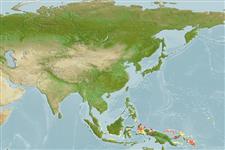Klassifizierung / Names
Namen | Synonyme | Catalog of Fishes(Gattung, Arten) | ITIS | CoL | WoRMS | Cloffa
>
Gobiiformes (Gobies) >
Gobiidae (Gobies) > Gobiinae
Etymology: Trimma: Greek, trimma, -atos = something crushed (Ref. 45335); aturirii: Named for Abraham Aturiri, Governor of West Papua province (2006-2016)..
Environment: milieu / climate zone / depth range / distribution range
Ökologie
seewasser riff-verbunden; tiefenbereich 38 - 70 m (Ref. 102609). Tropical
Western Pacific: Indonesia, West Papua.
Size / Gewicht / Alter
Maturity: Lm ? range ? - ? cm
Max length : 1.9 cm SL Männchen/unbestimmt; (Ref. 102609)
Kurzbeschreibung
Morphologie | Morphometrie
Rückenflossenstacheln (insgesamt): 7; Rückenflossenweichstrahlen (insgesamt): 9-10; Afterflossenstacheln 1; Afterflossenweichstrahlen: 9 - 10. This species is unique in the having the following characters: 2 dark oblique stripes on either side of the pupil (blue, edged with red in life, dark brown in preservative), the lower one continues posteriorly across the dorsal margin of the opercle; bipartite colour pattern - dorsal half of the body red or orange, ventral half abruptly white or pale pink in life; with a narrow bony interorbital (?50 % pupil width), a moderate interorbital trench with a slight groove posterodorsal to the eye; cheek, opercle and predorsal midline are scaleless; without elongate spines in the first dorsal fin; D2 I,9-10; A 9; pectoral fin rays 17-18 (7-11 are branched); an unbranched fifth pelvic fin ray (Ref. 102609).
Often found perched individually on vertical surfaces at the back of crevices and overhangs. Collected with clove oil from exposed oceanic atoll with clear water, steep outer wall with small crevices and overhangs, coarse white coralline sand (38 m) and steep outer reef slope with white calcareous sand (40 m); the holotype from steep wall covered with coarse white Halimeda sand (60 m) (Ref. 102609).
Life cycle and mating behavior
Geschlechtsreife | Fortpflanzung | Ablaichen | Eier | Fecundity | Larven
Winterbottom, R., M.V. Erdmann and N.K.D. Cahyani, 2015. New species of Trimma (Actinopterygii, Gobiidae) from Indonesia, with comments on head papillae nomenclature. Zootaxa 3973(2):201-226. (Ref. 102609)
IUCN Rote Liste Status (Ref. 130435)
Bedrohung für Menschen
Harmless
Nutzung durch Menschen
Mehr Information
NamenSynonymeMetabolismusRäuberÖkotoxikologieFortpflanzungGeschlechtsreifeAblaichenSpawning aggregationFecundityEierEientwicklung
Alter/GrößeWachstumLänge-GewichtLänge-LängeLängenhäufigkeitenMorphometrieMorphologieLarvenLarven Pop.Dyn.RekrutierungDichteBRUVS
ReferenzenAquakulturAquakultur ProfilZuchtlinienGenetikElectrophoresesVererbbarkeitKrankheitenVerarbeitungNutrientsMass conversion
PartnerBilderStamps, Coins Misc.LauteCiguateraGeschwindigkeitSchwimmstilKiemenoberflächeOtolithsGehirngrößeSehfähigkeit
Tools
Zusatzinformationen
Download XML
Internet Quellen
Estimates based on models
Preferred temperature (Ref.
123201): 27.6 - 28.8, mean 27.8 °C (based on 6 cells).
Phylogenetic diversity index (Ref.
82804): PD
50 = 0.5000 [Uniqueness, from 0.5 = low to 2.0 = high].
Bayesian length-weight: a=0.00708 (0.00333 - 0.01504), b=3.09 (2.92 - 3.26), in cm total length, based on LWR estimates for this (Sub)family-body shape (Ref.
93245).
Widerstandsfähigkeit (Ref.
120179): hoch, Verdopplung der Population dauert weniger als 15 Monate. (Preliminary K or Fecundity.).
Fishing Vulnerability (Ref.
59153): Low vulnerability (10 of 100).
